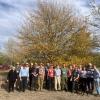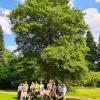Editor's Picks
Plant Focus
Quercus georgiana is an endangered US endemic oak species that exists in only a few scattered populations on granite outcrops of the Piedmont region in the southeastern US (GA, AL, NC). The largest and best documented population is from the type locality on Stone Mountain, GA. It is suspected that the last remaining population in North Carolina is down to just five individuals, and the remnant populations in South Carolina, part of the historic range of this species, are now extirpated (Oldfield and Eastwood, 2007; Toppila, 2012; P. Manos, pers. comm. 2014). It is also believed that the scattered remaining populations are introgressing with other sympatric and more abundant Red Oak (section Lobatae) species (R. Reynolds, pers. comm. 2015). Q. georgiana is ecologically important in the Piedmont region as a source of food for many birds and mammals. It also has great potential horticultural value with glossy leaves, brilliant fall color, drought tolerance, and resistance to deer browsing.

Q. georgiana is an “exceptional species” in that its acorns cannot be seed banked through conventional methods. Thus, ex situ conservation collections of this species must be through living individuals, requiring the involvement of botanical gardens and arboreta in conservation efforts. Previous research has found Q. georgiana is maintained in ex situ collections at 30 institutions around the world, 15 of which are in the US. Within these collections, there are only 26 accessions of known wild origin, most of which are from the same population of individuals on Stone Mountain, GA (Toppila 2012).

Scientists from The Morton Arboretum and Chicago Botanic Garden are now conducting a conservation genetics project that employs nuclear microsatellite and chloroplast markers to compare levels of genetic diversity between ex situ collections and individuals sampled from remaining wild populations of Quercus georgiana. The results of this analysis will reveal how much genetic diversity is currently being captured by existing botanical garden collections and inform the strategy for future collecting trips. The analysis will also elucidate the reproductive population dynamics of the wild populations and help identify those populations harboring the most valuable genetic diversity for prioritizing conservation action. Additional outputs of this study will be to refine the known distribution of this species through population surveys and to complete an up to date assessment for the IUCN Red List of Threatened Species.

The overall mission of this project is to build on the previous research by R. Toppila and A. Kramer (2012) to gain a complete understanding of the geographic distribution and genetic diversity in Q. georgiana to ensure that ex situ collections are capturing as much of the gene pool as possible.
In spring 2015, Murphy Westwood will be contacting garden curators across the US and abroad to request leaf samples of wild-collected Q. georgiana. Many US gardens have already been sampled, but no collections from outside of the US are yet included in this study. If you have wild-collected Q. georgiana accessions in your collection and have not yet contributed samples to this study, or if you have knowledge of wild populations outside of Stone Mountain, GA, please contact Murphy at mwestwood@mortonarb.org and she will provide you with sampling and shipping information.
References
Oldfield, S. and A. Eastwood. 2007. The Red List of Oaks. Fauna & Flora International, Cambridge, UK.
Toppila, R. 2012. Ex situ conservation of oak (Quercus L.) in botanic gardens: A North American perspective. Master of Science thesis, University of Delaware.















